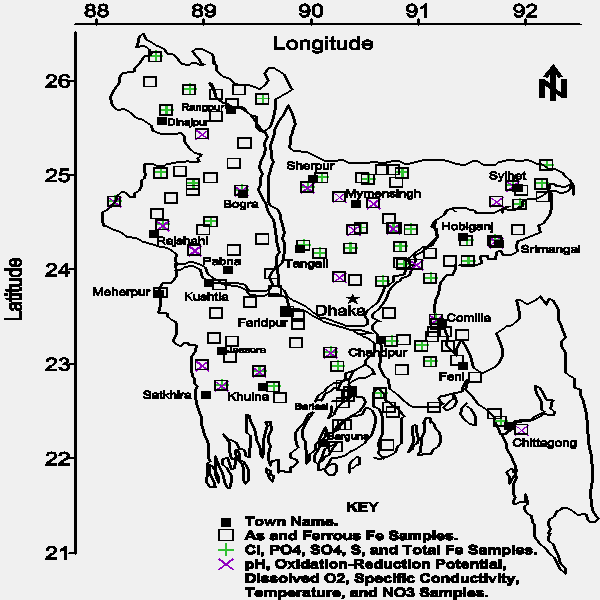
Groundwater samples were collected from approximately 120 villages throughout Bangladesh during July 22 to August 14, 1997. These villages were distributed as evenly throughout the country as practicable to map the distribution of groundwater results on a national-scale (see Figure 1).
 |
| Figure 1. Locations where groundwater samples were collected from tubewells. |
Typically 4 to 6 tubewells per village were sampled to evaluate the variability of groundwater results on a village-scale.
All groundwater samples were collected, preserved, and stored using a protocol developed by the authors of this study, the Government of Bangladesh Department of Public Health Engineering, and the World Bank (4). An important component of this protocol was to definitively record the location of each sampled tubewell. Accordingly, the latitude and longitude of all sampled tubewells were determined using the Global Positioning System. The district, thana, and village of all sampled tubewells were documented. Detailed sketches showing the locations of all sampled tubewells within each village were drawn. The owner and the owner's reported depth of each sampled tubewell were recorded.
Another important component of this protocol was to ensure that each tubewell sample was representative of groundwater quality by using established collection, preservation, and storage methodologies (5 and 6). Accordingly, all sampled tubewells were purged a minimum of 1 pump stroke of groundwater for each reported foot of depth immediately before sample collection. All samples were collected directly into polyethylene bottles. These samples were not filtered. All samples submitted for total arsenic and ferrous iron analyses were acidified to pH < 2 with 10% (volume:volume) HCl and stored in ice-packed coolers immediately after collection. All samples submitted for chloride, phosphate, sulfate, sulfide, and total iron were stored in ice-packed coolers immediately after collection. The temperature of all stored samples was maintained at 0°C to 4°C until immediately before analysis.
All analyses were performed at the International Centre for Diarrhoeal Disease Research, Bangladesh (ICDDR,B) laboratory, unless otherwise stated. All groundwater samples were analyzed within the Maximum Recommended Storage Time specified in Standard Methods for the Examination of Water and Wastewater (5). Approximately 600 samples were analyzed for total arsenic by the silver diethyldithiocarbamate method (7) and ferrous iron by 1,10-phenanthroline (7, see Figure 1). Approximately 100 samples were analyzed for chloride by mercuric thiocyanate (8), total acid-hydrolyzable phosphate by amino acid (8), sulfate by barium turbidity (8), sulfide by methylene blue (8), and total iron after acidic digestion by 1,10-phenanthroline (8). Approximately 75 samples were analyzed immediately after collection for pH by glass electrode (5), oxidation-reduction potential by electrode (5), dissolved oxygen by membrane electrode (5), specific conductivity by electrode (5), temperature by thermocouple, and nitrate by cadmium reduction (8).
The performance of the sampling teams and the ICDDR,B laboratory staff was evaluated by the blind analysis of independently prepared standard solutions, the recovery of known additions of standard solution to samples (sample matrix spikes), the blind analysis of distilled water blanks prepared in the field, the blind analysis of duplicate samples collected by the same sampling team, and blind collection of duplicate samples by different sampling teams. The performance of 3 other local laboratories researching arsenic in Bangladesh was evaluated by the blind analysis of independently prepared standard solutions, the blind analysis of sample matrix spikes, and the blind analysis of duplicate samples.